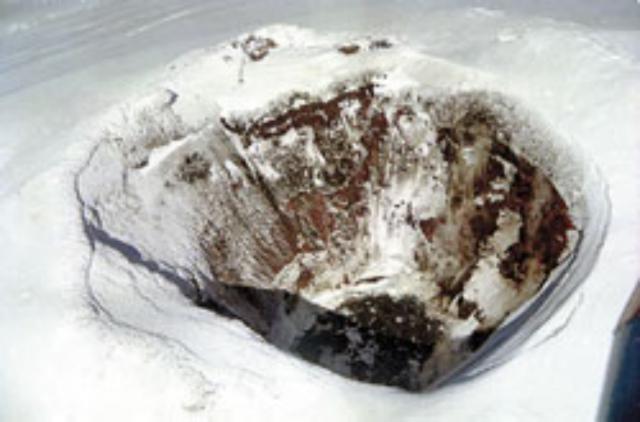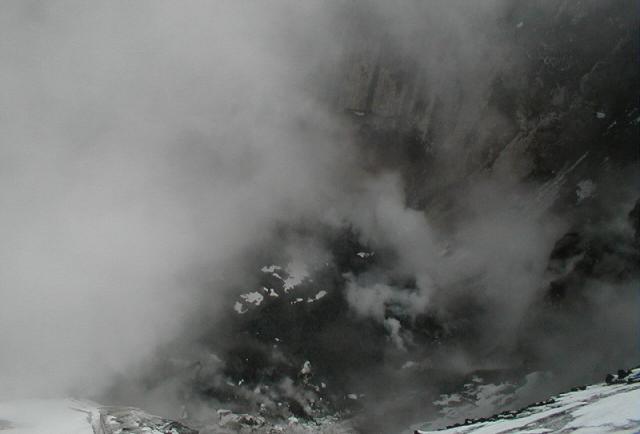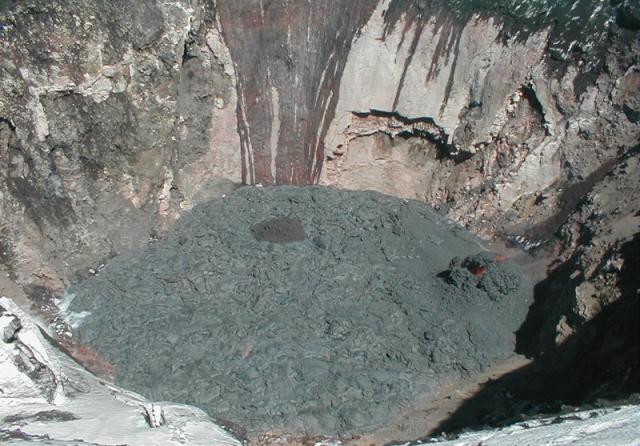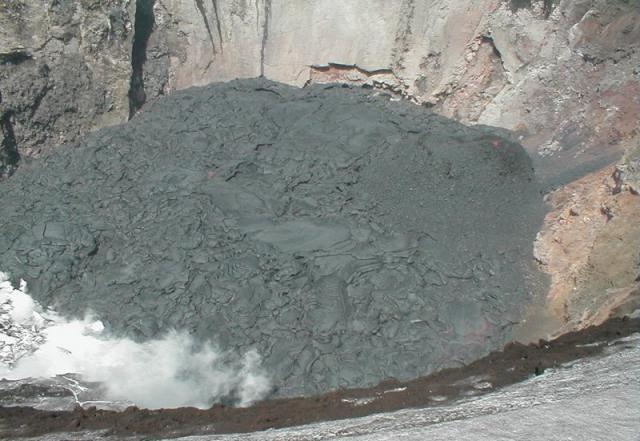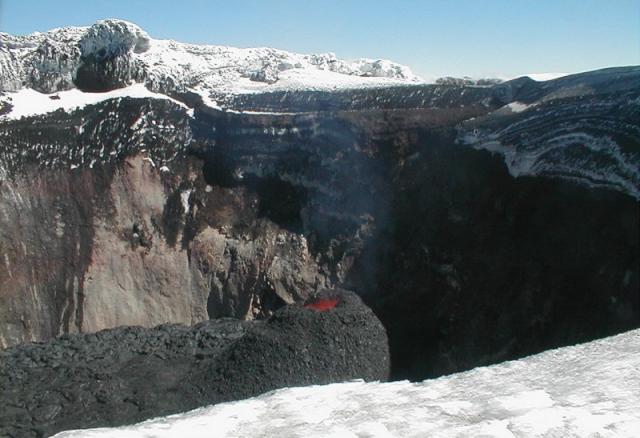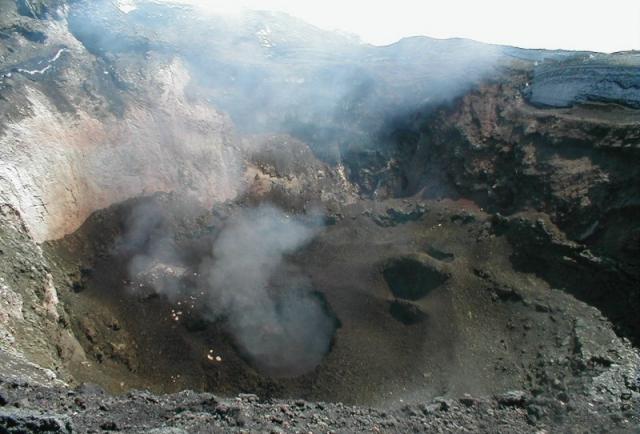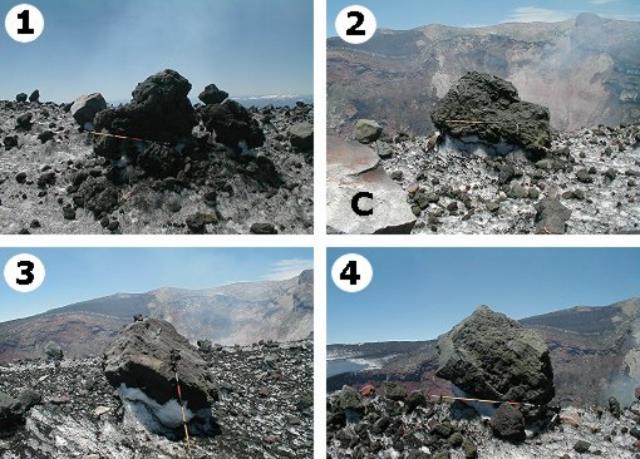Report on Villarrica (Chile) — March 2001
Bulletin of the Global Volcanism Network, vol. 26, no. 3 (March 2001)
Managing Editor: Richard Wunderman.
Villarrica (Chile) Pahoehoe steadily fills crater; gas discharges and explosions in October-December 2000
Please cite this report as:
Global Volcanism Program, 2001. Report on Villarrica (Chile) (Wunderman, R., ed.). Bulletin of the Global Volcanism Network, 26:3. Smithsonian Institution. https://doi.org/10.5479/si.GVP.BGVN200103-357120
Villarrica
Chile
39.42°S, 71.93°W; summit elev. 2847 m
All times are local (unless otherwise noted)
Since the last report (BGVN 25:10), Villarrica's summit crater continued to be active during October-December 2000.
October 2000 activity. On 18 October the crater bottom lay 70 m below the snow-and-ice-covered summit, it appeared solid and had no visible evidence of disturbance due to underlying fresh lava (figure 9). That night and through the following morning, however, the volcano emitted a small ash-and-gas plume that drifted ENE toward the community of Chinay-Palguín.
On 24 October abundant thermal activity from the crater was observed. Ice and snow that fell from the crater rim down the crater sides and bottom generated enough steam to largely obscure the crater's base (figure 10). When observed on 27 October, the bottom of the crater had increased several meters in height due to outpouring of volatile-poor pahoehoe lava from a small incipient cone and other subsidiary vents (figure 11). Activity consisted of ejection of incandescent material about every 2 minutes, but was not accompanied by degassing sounds. By 30 October, lava had further filled the crater (figure 12, compare to figure 11), but the slow rate of lava discharge prevented the formation of a molten lava lake.
November 2000 activity. The emergent crater bottom reached its maximum height on 1 November (figure 13). Weak incandescence (degree 1 on a scale of 1-5) and ejection of material every ~1-2 minutes could be observed from a point 13 km away that night. By this date the crater was filled with a volume of ~350,000 m3 of material, more than half its capacity. The average effusion rate was estimated to be ~0.45 m3/s during 24 October-1 November.
December 2000 activity. Villarrica produced intense showers of lapilli that retextured the crater bottom during 3-5 December; further extrusion of pahoehoe lava filled up the minor depression of a collapse structure. Gas emission decreased, and a lava lake with a thin solidified crust and a 10-m diameter was observed by the end of the interval. Moderate incandescence (degree 3 on a scale of 1-5) and collapse of the cone were observed on 19 December (figure 14).
Explosive activity. The crater rim was blanketed by abundant ash and lapilli, and on the NW terrace several large bombs and blocks were found, evidencing one or several violent explosions during late 2000 (figure 15). A high risk of explosions remained at the end of the year because lava had grown to such a great height within the crater.
Geological Summary. The glacier-covered Villarrica stratovolcano, in the northern Lakes District of central Chile, is ~15 km south of the city of Pucon. A 2-km-wide caldera that formed about 3,500 years ago is located at the base of the presently active, dominantly basaltic to basaltic andesite cone at the NW margin of a 6-km-wide Pleistocene caldera. More than 30 scoria cones and fissure vents are present on the flanks. Plinian eruptions and pyroclastic flows that have extended up to 20 km from the volcano were produced during the Holocene. Lava flows up to 18 km long have issued from summit and flank vents. Eruptions documented since 1558 CE have consisted largely of mild-to-moderate explosive activity with occasional lava effusion. Glaciers cover 40 km2 of the volcano, and lahars have damaged towns on its flanks.
Information Contacts: Werner Keller U., Proyecto de Observacion Villarrica (POVI), Wiesenstrasse 8, 86438 Kissing, Germany (URL: http://www.povi.cl/); Hugo Moreno, Observatorio Volcanologico de Los Andes del Sur (OVDAS), Casilla 23D, Temuco, Chile (URL: http://www.sernageomin.cl/).


